March 2019 Grant Recipients
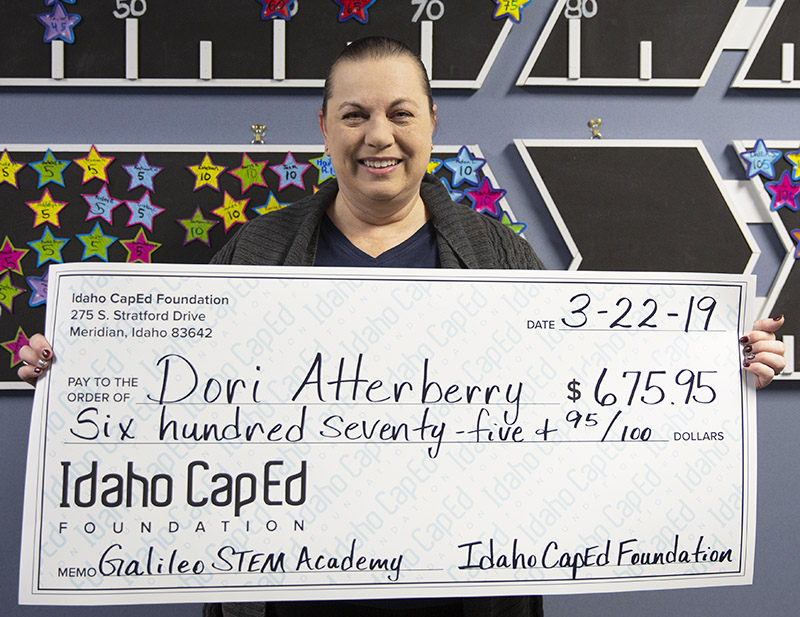
Hands-On Coding
Dori Atterberry - Galileo STEM Academy, Eagle
$675.95
Playing with blocks has been around for centuries. This age old toy remains one of the most important tools for children to use in developing critical thinking skills. Hands-On Coding Blocks allow children to physically move and act out algorithms. They take the computer out of computational thinking. Hands-On Coding Blocks turn the child into a computer and teach them not just how to solve problems, but also how to communicate, collaborate, and be creative! Kids learn by doing, which is why Hands-On Coding Blocks are a perfect tool to learn the fundamentals of computational thinking, in a fun and engaging way. Computer Science includes algorithms, functions, conditions and more. These concepts are often unfamiliar, abstract, and confusing to children. Coding Blocks help children develop the ability and confidence to fundamentally learn computer programming at a very early age.
Exothermic/Endothermic Reactions
Cindy Currie - Borah High School, Boise
$750.00
Students will design and test an effective and inexpensive way to make a hand warmer (exothermic reaction) or cold pack (endothermic reaction) using a coffee cup as calorimeter measuring the amount of heat lost or absorbed in a reaction. In this investigation, the students will choose to either make a cold pack or a hand warmer. The students will have the appropriate background information needed and will have done a structured investigation of both an exothermic and endothermic reaction. They will be provided a table of different possible salts to use and the price per gram for each salt. They will design and test their own experiment to determine a most effective and economical warm pack or cold pack. When testing the salts, the reactions happen quickly and the students will need to record the temperature of the reaction every 10 to 15 seconds, until it stops changing which takes anywhere from 1.5 minutes to 3 minutes. A precise temperature reading is important in this investigation. A digital thermometer will allow for accurate temperature measurement.
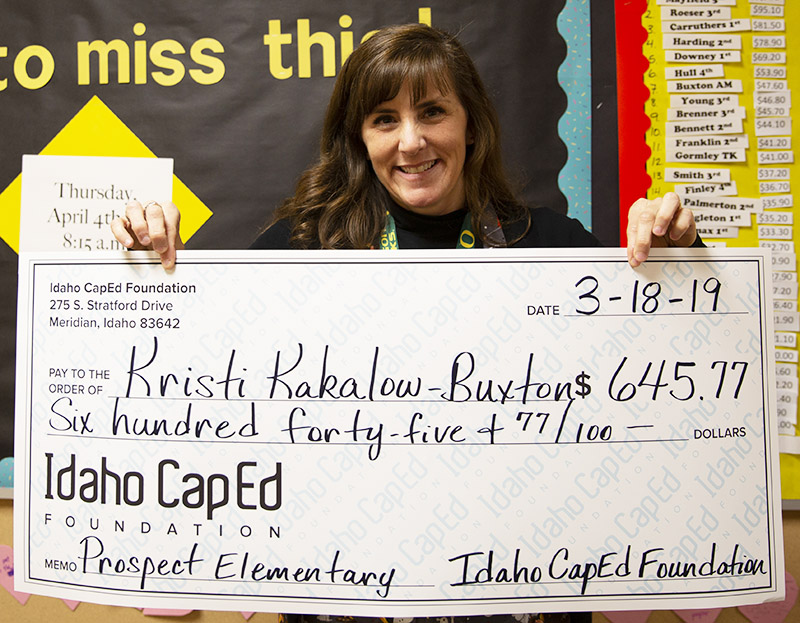
Hands-On Math Materials
Kristi Kakalow-Buxton - Prospect Elementary, Meridian
$645.77
We all know that students learn in many different ways: visual, auditory, tactile, kinesthetic, and social. These are active and engaging strategies that build motivation and enthusiasm for learning. It’s important for me to provide my students the opportunity to learn and explore, utilizing all of these strategies. I believe students should be engaged in child-centered, hands on activities that meet our district reporting standards. The activities this grant will support include: operations and algebraic thinking centers, counting & cardinality centers, numbers & operations in base 10, geometry centers, and manipulatives. The materials will provide teachers methods to reach each child through their own specific learning style. It will also allow the kindergarten teachers to meet the needs of children working above or below grade level.
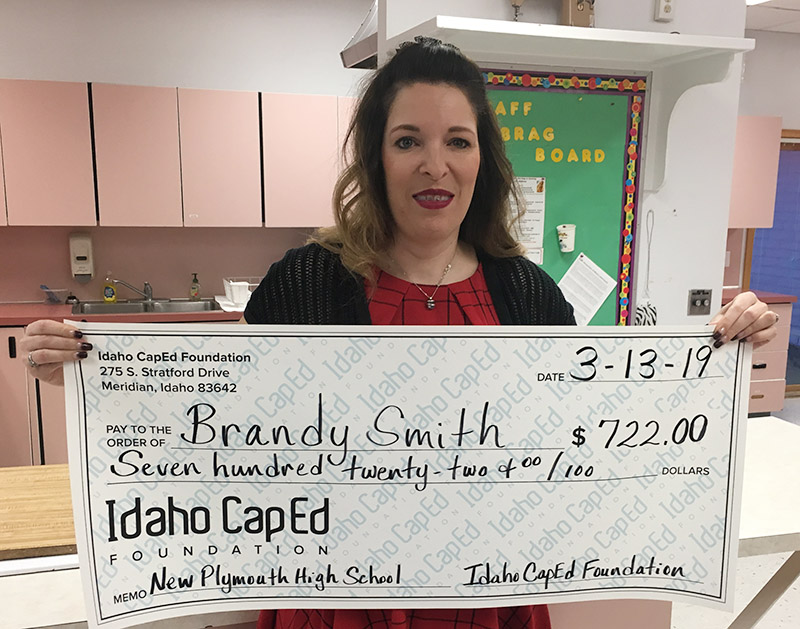
Adulting 101 - Reality Town
Brandy Smith - New Plymouth High School, New Plymouth
$722.00
Many students graduate high school missing some "basic" information such as how to balance a checkbook, how to complete a rental application, how to buy a car, how to change a tire, or oil in their car, etc. With the help of this grant, I would like to start an Adulting 101 day for our seniors, which would include Reality Town. Reality Town is a financial awareness and simulation program. Students are assigned a career and life situation (married, kids, etc.) and then have to balance their budget for the month after paying all of the bills that many of them don't consider as they get ready to leave the safety of home where most things are paid for by mom and dad. The expected outcome from this event is more financial awareness on the part of the students who are getting ready to graduate and join the workforce within the next several months or years.
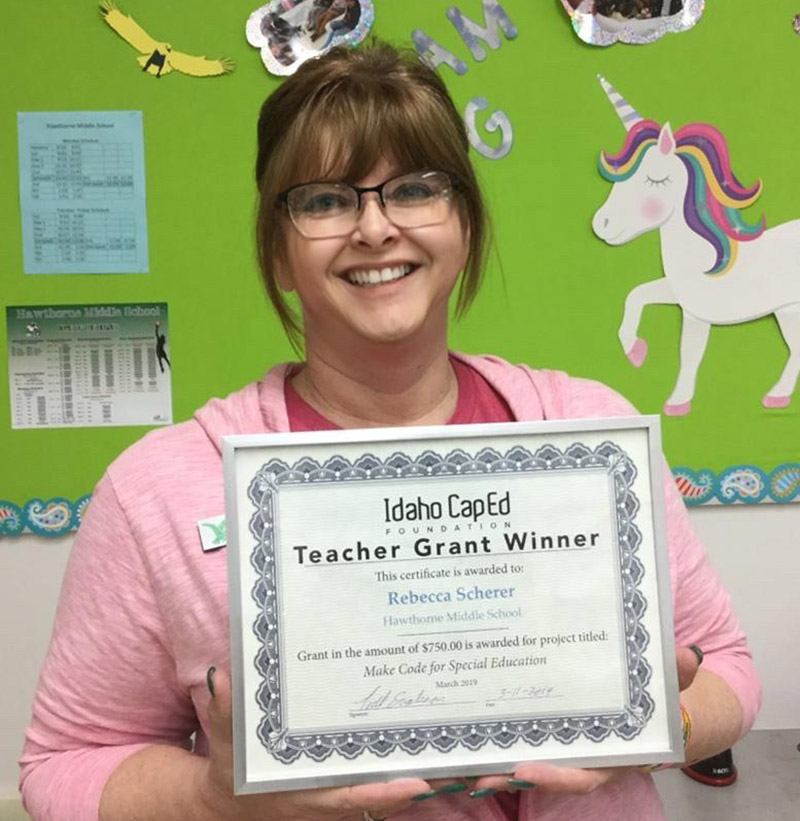
Make Code for Special Education
Rebecca Scherer - Hawthorne Middle School, Pocatello
$750.00
MakeCode is a web based code editor for physical computing that brings computer science to life for all students with fun projects. Teachers and students get immediate results, and both block and text editors for learners at different levels. Students new to coding start with colored blocks that they can drag and drop onto their workspace as they follow color coded instructions to construct their programs. This class will help students feel safe to work at a pace they are comfortable with and with students who are all beginners who have struggles. As their skills advance, they will be able to move into other STEM classes with the confidence that they can do this and they are learning skills that can lead to a career. Our school would be able to offer a class that would help bridge the gap for these students that come from lower socioeconomic status households that are not receiving the support necessary to overcome the struggles that derive from only having these opportunities in after school clubs and organizations.
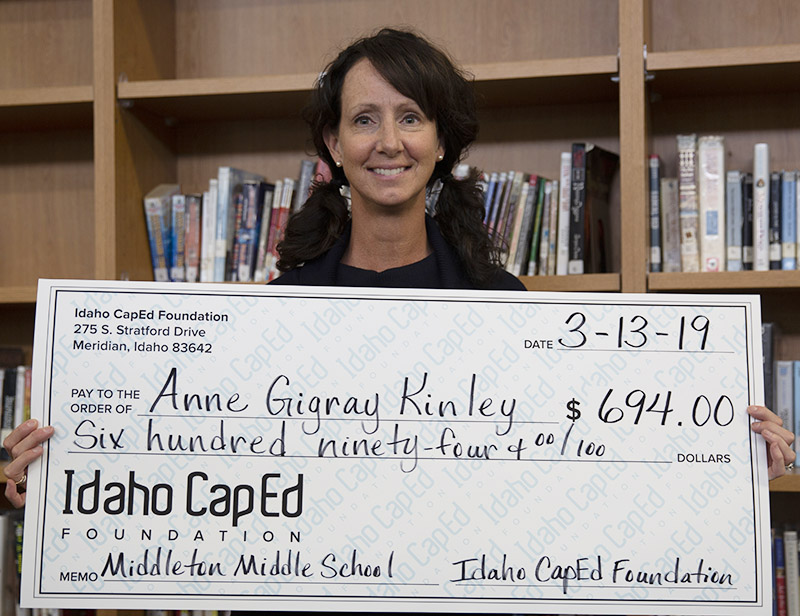
FCS Kitchen Equipment
Anne Gigray Kinley - Middleton Middle School, Middleton
$694.00
I teach FCS (Family and Consumer Science) and we have a trimester long study that covers 7 weeks of food and nutrition studies and a 5 week study of sewing and needle work. During the 7 week food/nutrition unit, we have 5 hands on cooking labs where students are in kitchens creating given recipes. This grant will help fund needed supplies in order for the students to cook required dishes properly. We are also in need of a few new sewing machines to help alleviate over crowding of the 12 machines we currently have. Over 150 students will be impacted each trimester (that's over 450 students per year) with the help of this grant!
Cascade Creates!
Marla Blaser - Cascade School District, Cascade
$750.00
I want to introduce k - 5th grade students to ceramics and printmaking and work with teachers so that they can integrate art into cross curricular activities. By giving teachers these skills and access to ceramics and printmaking equipment, student engagement in art will increase as part of regular instruction. I will establish a supply check out system and create clear instruction guides for printmaking and ceramics to ensure that this program runs smoothly. I will also work with the Cascade After-School program, which has access to the art-room for extracurricular enrichment. Over 100 k-6th grade students will acquire skills in printmaking and ceramics through regularly scheduled workshops like relief printing or hand-building ceramics. For example, students will learn about positive and negative space while creating block prints.
Eureka Math Manipulatives
Bryan Brasher - Cascade Elementary, Cascade
$229.00
The purpose of this project is to aid in Math and STEM development of fourth grade students. The grant will help purchase math manipulatives that have been designed to accompany the Eureka Math curriculum we utilize. These manipulatives will be used to enrich the curriculum, provide students with hands on learning opportunities, and shift the economic burden from the district, faculty, and families. Providing students the opportunity to have quality manipulatives will increase student engagement, provide opportunities for project based learning, and provide novelty and variety to meet different learning needs. This will help strengthen math skills in fourth grade and better prepare students for fifth grade and beyond.
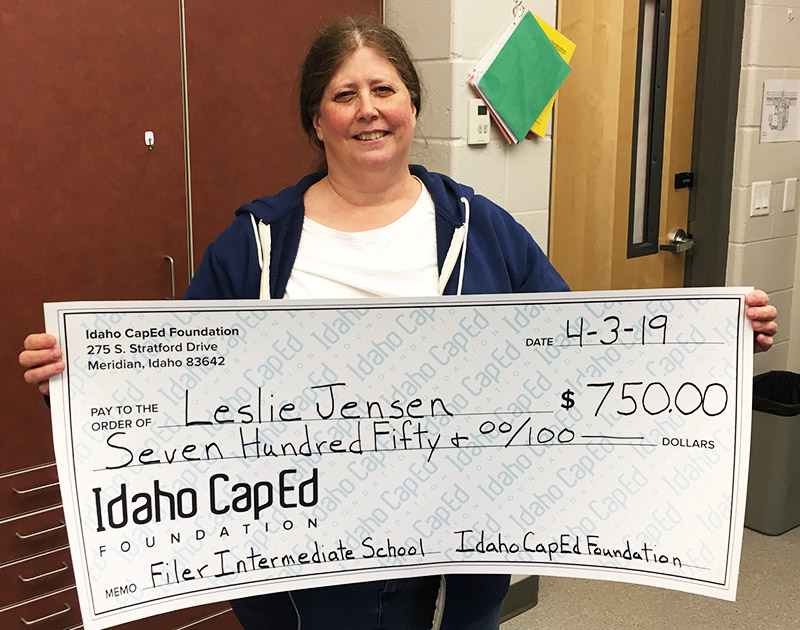
Assessment and Testing
Leslie Jensen - Filer Intermediate School, Filer
$750.00
Special Education provides individualized instruction for students who learn differently or at a different pace. In order to design the individualized program of instruction, educators utilize thorough evaluations of scores provided by assessment devices such as Woodcock-Johnson IV, Tests of Achievement. This battery of tests allows examiners to maintain a singe testing source from early childhood assessment through advanced interpretation of results, with comprehensive testing repeated every three years as the child advances from school to school. Our eight Special Education teachers and evaluators at the Elementary and Intermediate schools are sharing one WJIV kit on two different school campuses. The demand for the kits often creates a logjam, delay in testing and, ultimately, a delay in implementing individualized instruction plans for students with disabilities. This grant will be used to purchase another kit to help fill this need.
Classroom Library
Erin Beggs - Sacajawea Jr. High, Lewiston
$717.40
My project will be replacing and adding to my classroom library of novels that are of high interest to young men and women that read below grade level. My hope is to provide my students with the opportunity to read novels that are highly engaging and encourages them to want to read more. Students who read below grade level often struggle with self confidence. Being able to successfully read a book of interest can help build that confidence. As their confidence grows with reading, their writing skills will improve as well. These text will be used as exemplars to show author’s craft and to encourage students as writers. This project will enhance students achievement and talents by increasing knowledge because the more you read, the more you do know. It will expand students vocabulary, improve reading comprehension, and fluency. Students will be exposed to different genres and writing styles and can then expand their educational opportunities by applying new found skills in their writing as well as other subjects areas.
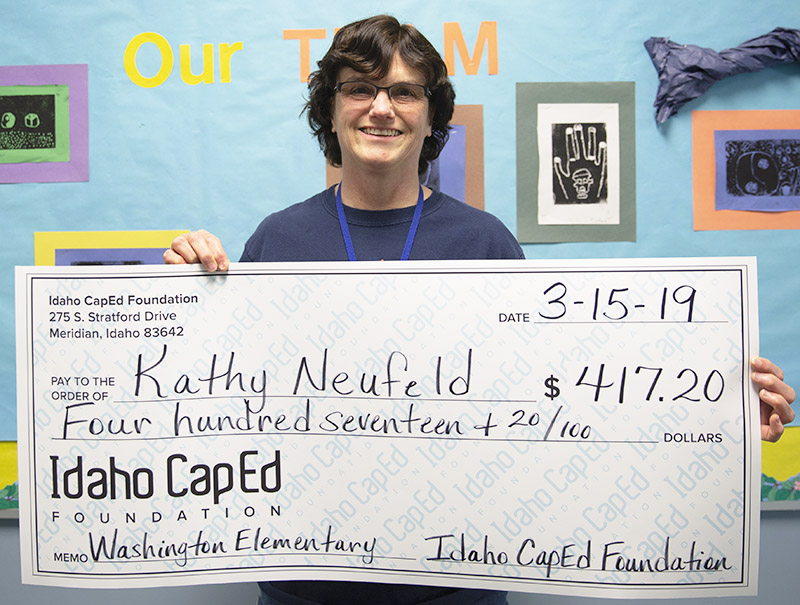
Let's Read!
Kathy Neufeld - Washington Elementary School, Caldwell
$417.20
The ultimate goal of "Let's Read!" is to promote lifelong readers and to develop literacy in students who have basic and emerging skills. "Let's Read!" consists of two components. One is the ReadnQuiz which is an online reading incentive and accountability program that quizzes students on the books they have read independently. I would like to purchase the program for all four Second Grade classes. The second component is "Horrible Harry in Room 2B" book set for use in my Intervention Reading Group. The "Horrible Harry" series, written by Suzy Kline, has been entertaining children for thirty years. I have chosen this book because the subject matter is relevant to students of this age, and there are just enough challenging words and literary devices to expand our students' vocabulary and comprehension skills. I will purchase twenty copies of the book to use with a middle to higher level reading group.
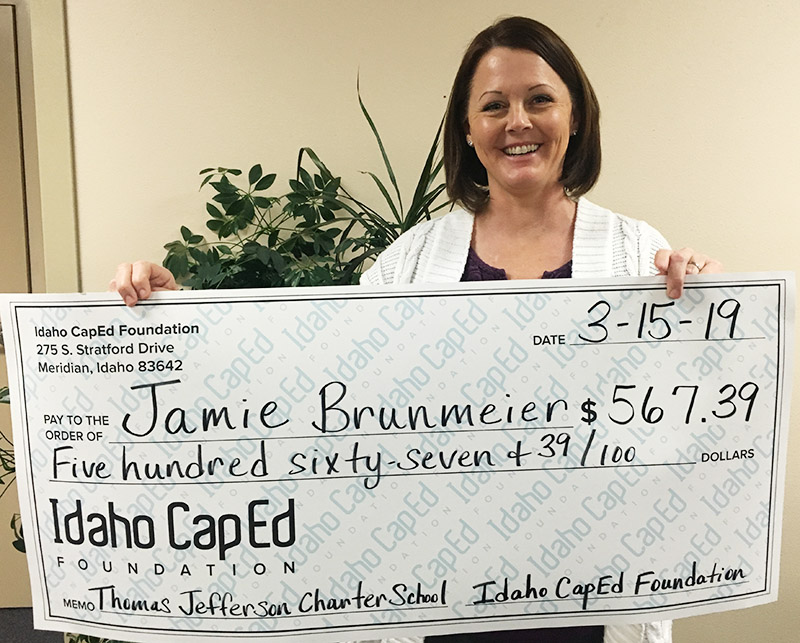
Kick the Plastic!
Jamie Brunmeier - Thomas Jefferson Charter School, Caldwell
$567.39
Our school is in need of a water bottle filling station. When people drink from a regular fountain (especially children) they tend to put their mouths on the part where the water comes out. This is how bacteria and other pathogens travel. This water bottle station will reduce the sick building syndrome (which my Environmental Science students study and track). There will be less contact of hands and mouth when getting water, thus keeping students and teachers healthy and reduce time out of school. The water station can maintain hydration, and can improve school performance. Poor hydration effects the mental performance and learning ability. We will also reduce environmental pollution by not using plastic H2O bottles. If we have the water filling station, we will have a better planet with less plastic in oceans, we are saving the environment.
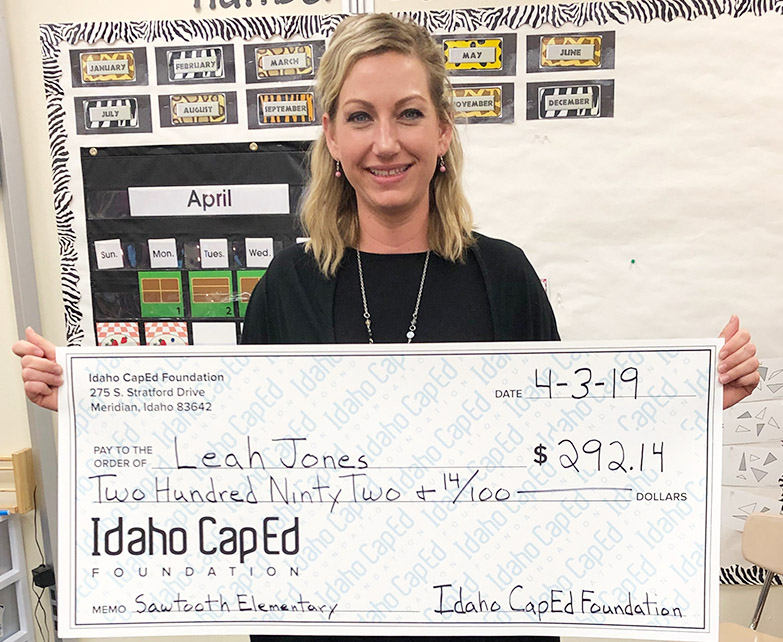
Putting the A in STEM
Leah Jones - Sawtooth Elementary, Twin Falls
$292.14
The focus for this lesson is creativity and putting the A in STEM. Students will be encouraged to think outside of the box and focus on problem solving through creative and innovative thinking. Students will be able to explore their body movements through Yoga led by an instructor and then develop additional movements to a routine selected of their choice. Students will design and create a “Fantasy Miniatures” model using both digital tools and non-digital tools with guidance and modeling from the teacher and a volunteer instructor. Students will classify colors, shapes, and pigmentation through creating and designing their own landscape portrait and they will sketch, draw, and design a self-portrait of themselves using measurement of their attributes such as length from ears to neck and eyes to nose. Lastly, students will be able to identify and write on how creative thinking and artistic design can help them become more creative in finding solutions and think critically about problems that occur and finding inventive solutions.